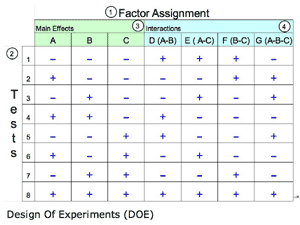 Every factor operates at different levels or stages during a process. These levels are either determined so that the process adds value to the product and hence there is a value associated with it. As an example, a flight management over booking could be set at two levels, one which takes low levels of risk and other which takes high risk. The factor here is risk, the levels are low and high. When you bake a cake, the factor are temperature and time in the oven, you could keep at high temperature or low temperature and this can be done at several levels of time. Every factor operates at different levels or stages during a process. These levels are either determined so that the process adds value to the product and hence there is a value associated with it. As an example, a flight management over booking could be set at two levels, one which takes low levels of risk and other which takes high risk. The factor here is risk, the levels are low and high. When you bake a cake, the factor are temperature and time in the oven, you could keep at high temperature or low temperature and this can be done at several levels of time.
The objective in this experiment is to make a perfect cake. The factors that contribute value, like temperature and time are also the same factors that contribute to the issue or problem. Thus variation in output is contributed by mostly change of levels in these factors. Identifying these levels and finding their relation to the issue or failure is important in the Deep Analysis process.
Probablity of detection in NDT using Designed experiments
Qualimations supports Design of experiments (DOE) for validating probability of detection capability of non-destructive testing systems.
DOE is a diagnostic tool providing detailed analysis of POD test data and guidance on establishing data distribution requirements and resolving test issues.
The objectives of the DOE application in NDT are as follows.
Which factor has significant influence on the UT data output / the probability of weld?
At what level of the factor the error is minimum?
Factorial analysis provides a cost-effective means for solving problems and developing new processes. The simplest DOE tool is a 2 Factor by 2 Level experiments
also called 2 power 2 factorial design. Here each factor (Evaluation method, Transducers, Locationů) is evaluated at 2 level say Low and High or type1 or 2.
The study is also replicated adequate enough to evaluate the effect of noise in the NDT process. The ANOVA method of analysis is now used to help
determine which inputs of factor have the greatest effect on outputs against the noise. It also helps in identifying the best level for the factors
that maximises the output or reduces the error. This analysis allows one to determine the configuration that yields the smallest error and also indicates
the experimental parameters, which have the greatest influence on the changes in the final results.
Qualimations will be able to support in advanced statistical analysis by using the following statistical tools.
Statistical data Analysis of Variance.
One /two and multiple Factor Experiments.
Model evaluation and Equations.
Residual Analysis and Normal Probability plots.
Hypothesis Testing T and F tests.
One /two and multiple Factor Experiments.
DOE complete Course Duration: 20 Hrs of classroom session with practical application.
Sample Data analysis depends on the domain of the data and type of report requested.
A smaller version shall also be provided based on requirement and further discussion.
|
Assume you have 2 factors that affect your low output problem or your sales problem, then a properly designed experiment can answer some of these Questions.
| Which factor has more influence on the problem ? |
| At what level of the factor the problem is minimum ? |
| At what level of the factors the factors other that the two you know affect the least. |
|
|

 Every factor operates at different levels or stages during a process. These levels are either determined so that the process adds value to the product and hence there is a value associated with it. As an example, a flight management over booking could be set at two levels, one which takes low levels of risk and other which takes high risk. The factor here is risk, the levels are low and high. When you bake a cake, the factor are temperature and time in the oven, you could keep at high temperature or low temperature and this can be done at several levels of time.
Every factor operates at different levels or stages during a process. These levels are either determined so that the process adds value to the product and hence there is a value associated with it. As an example, a flight management over booking could be set at two levels, one which takes low levels of risk and other which takes high risk. The factor here is risk, the levels are low and high. When you bake a cake, the factor are temperature and time in the oven, you could keep at high temperature or low temperature and this can be done at several levels of time.